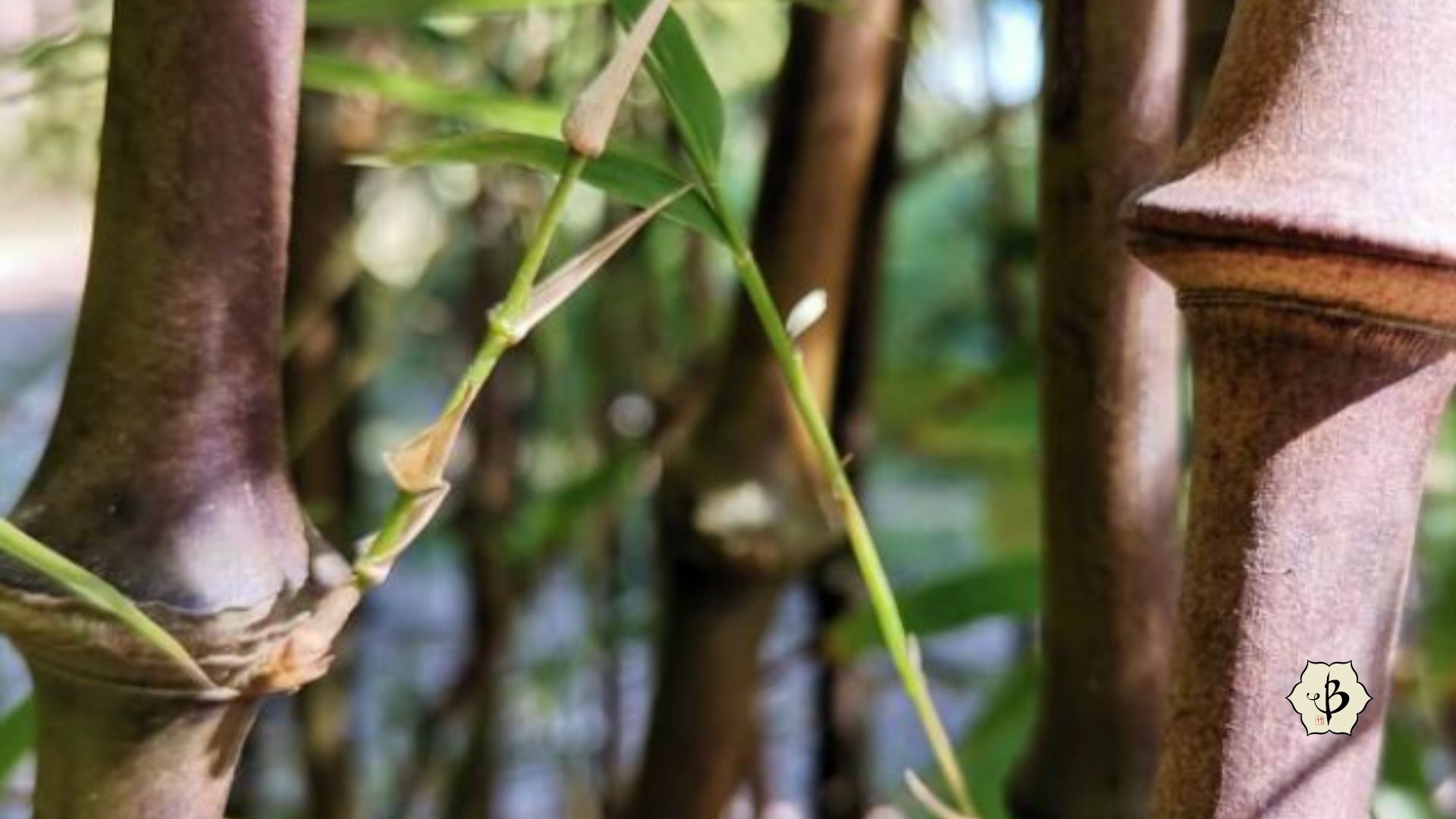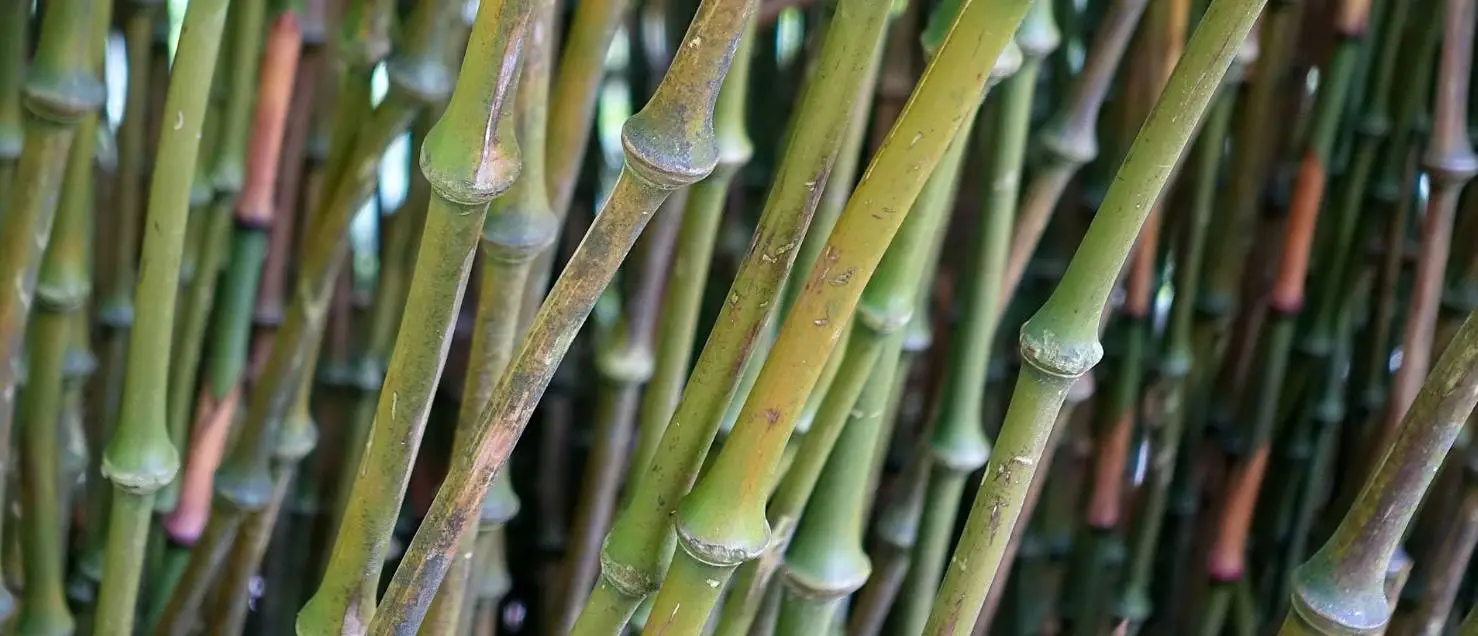Trying to learn every variety of bamboo can be a bit like memorizing every bone in the human body. While there’s only 206 bones in an adult, the number of bamboo species is something in the neighborhood of 1,400, divided into roughly 100 genera. Botanists classify bamboo according to features like their rhizome types, branching patterns and native habitat. Phyllostachys and Bambusa are probably the most widespread and important genera, both commercially and ornamentally. But real bamboo enthusiasts looking to diversify their garden should also know about the genus Chimonobambusa.
Chimonobambusa is an East Asian genus of medium-sized, shade-loving, running bamboos, consisting of about 40 species. For the most part, they are native to China, Japan, Myanmar and Vietnam. They are also found in the foothills of the Himalayas. Despite having running rhizomes, they are not as fast-spreading as other varieties, like Phyllostachys. They are most notable for their unusual culms and knobby nodes. The most popular species for ornamental cultivation are Walking Stick bamboo (C. tumidissinoda) and Square bamboo (C. quadrangularis).
This post — first published in October 2020 and updated most recently in May 2024 — is part of an ongoing series about different types and species of bamboo. To learn more about this fascinating and diverse sub-family of grasses, check out these other articles.
- Running bamboo
- Clumping bamboo
- Genus Chusquea: Solid bamboo of the Americas
- Genus Fargesia: Clumping bamboo for cold climates
- Genus Himalayacalamus: Bamboo of the mountains
- Genus Phyllostachys: Prolific bamboo for all climates
- Native bamboos of North America: Arundinaria
- Herbaceous bamboo: Olyreae
Characteristics of Chimonobambusa
TEMPERATE HABITAT
Members of the genus Chimonobambusa are native to East Asia, mostly coming from China, Japan, Vietnam, Tibet and parts of the Himalayas. So unlike the tropical and subtropical bamboos, primarily indigenous to places like Indonesia, South East Asia and Central or South America, Chimonobambusa is far more tolerant to cold temperatures.
Though not as hardy as some varieties of Phyllostachys, which can survive temperatures as low as -20º F, Chimonobambusa can definitely withstand freezing winters. The most common species are cold hardy to about 10º or 15º F. In fact, they are more particular about heat, preferring at least some partial shade, especially in the warmer climates.

RUNNING ROOTS
Like the vast majority of temperate bamboos, these are runners.
When classifying bamboo, one of the most important characteristics will be its type of rhizomes. Basically, bamboos are either runners or clumpers. Runners, including Chimonobambusa, have long, narrow rhizomes roots that race outward, parallel to the ground and away from the main plant. Botanical terms for these rhizomes are leptomorph and monopodial.
These kinds of bamboo can be especially vigorous, and potentially invasive. Although most kinds of Chimonobambusa are not particularly aggressive, as far as running bamboos go. Still, you should almost always use some kind of root barrier when planting a running bamboo. Natural boundaries are great, like cliffs, waterways and rock formations. But most gardeners will use root barriers like Bamboo Shield or Deep Root, which both come in a variety of sizes and thicknesses and are available from Amazon.
Clumping bamboos, by contrast, have what are called pachymorph or sympodial rhizomes. These are shorter and thicker, and tend to have more of a u-shape, curving upwards to put up new shoots close to the main plant. Many gardeners find clumping bamboos easier to maintain. But runners have the advantage of growing more quickly, and Chimonobambusa varieties have other desirable features.
EYE-CATCHING CULMS
The most distinctive characteristic of the genus Chimonobambusa, and what makes them so desirable among gardeners, are the unusually shaped culms and nodes. The nodes are often very pronounced, as with the Walking Stick bamboo (pictured below). This produces a very interesting visual effect, making it attractive in the garden and for crafting purposes.

Several species actually have square instead of round culms, which looks especially interesting and unusual. C. quadrangularis and C. armata are some of the best examples of this.
Another feature is that the branches don’t usually begin until after about 3 or 4 feet. This allows the bamboo to more easily show off its eye-catching culms, at least on the bottom portion of the plant.
USES
The combination of a running growth habit and its interesting appearance makes Chimonobambusa an excellent candidate for a hedge or a low privacy screen. If you contain it and keep it well-pruned, it can also be a beautiful centerpiece or specimen plant in the garden. The shapely culms are also ideal for crafting, and for walking sticks in particular, as the name suggests.
Species of Chimonobambusa
Chimonobambusa quadrangularis: If you’re looking for something to stand out in an already interesting bamboo garden, “Square bamboo” makes a great addition. They can grow 15-25 feet tall, with remarkable square culms about 1-1.5 inches thick. The plants are cold hardy to about 10º F, and prefer lots of shade, especially if temperatures consistently get into the 80s or hotter. Shade and ample watering will help keep the leaves lush and green. Not drought tolerant.

Real bamboo connoisseurs should look for C. quadrangularis “Suow” or “Golden square stem”, a striped cultivar with similar traits but occasional yellow stripes on the otherwise green culms.
C. tumidissinoda: Commonly known as “Walking Stick bamboo”, or as Qiongzhuea tumidinoda in China, this is probably the most popular species of this genus. In addition to its distinctively prominent nodes (pictured above), this bamboo also has very graceful foliage, arching at the tops with small, delicate leaves. Plants can grow 5-15 feet tall, with nodes about 1 inch thick. It prefers at least some shade, and is cold hardy to about 5º-10º F.
C. marmorea: “Marble bamboo” have light green shoots with marbled brown-white culm sheaths. As the sheaths fall away, the culms turn a rich, deep green, growing up to 4 or 8 feet tall. Nodes are a bit knobby, but not as pronounced as in other species. Slender canes, about 3/4 inch thick, arch somewhat as they get taller, for a very elegant appearance. Likes ample watering with good drainage, and partial shade. Cold tolerant down to 5º-10º F.
Because the classification of bamboo can be so challenging, many species that once belonged to the genus Chimonobambusa have since been renamed. Several of them have been identified as clumping bamboo and now belong to other genera, such as Ampelocalamus, Bambusa, Chimonocalamus, or Drepanostachyum.
Further reading
If you’d like to learn more about the many uses and varieties of bamboo, take a look at some of our other popular articles.
- Growing Bamboo: The complete how-to guide
- Growing bamboo in the shade
- Best bamboo varieties for your garden
- Preparing your bamboo for winter
- Bamboo anatomy: 9 parts of the bamboo plant
FEATURE IMAGE: Graceful, wispy leaves of Chimonobambusa tumidissinoda, or Walking Stick bamboo, in all its glory. Photo by Fred Hornaday.




















